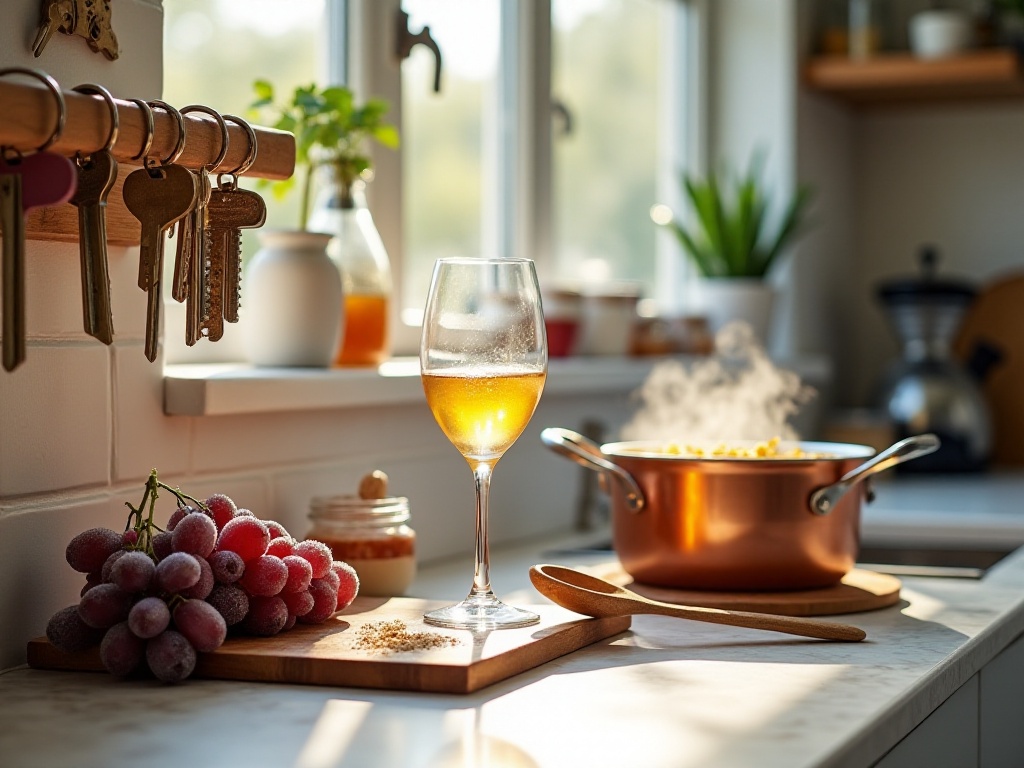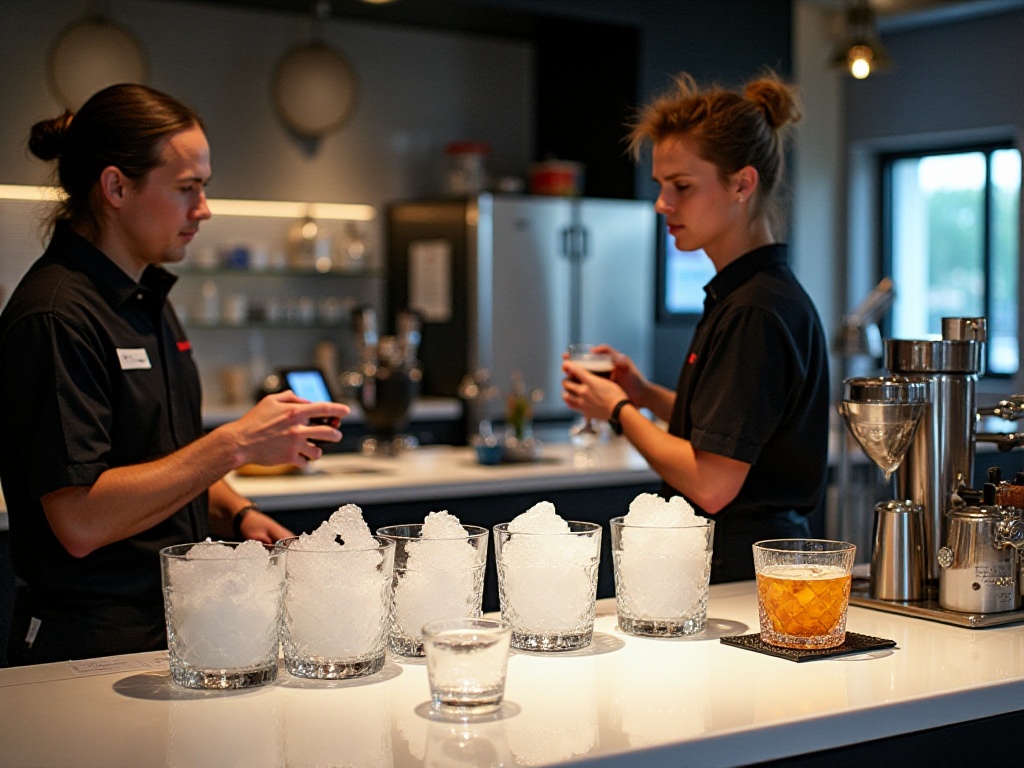
Introduction
As a fresh graduate who just started working, cooking dinner after getting home is one of the biggest headaches. Looking at all those exquisite food photos in social media feeds, then looking at the messy ingredients on my cutting board, I feel completely overwhelmed. However, after years of trial and error, I've finally found a set of lazy tricks that work for me. Today I'll share my experience with everyone, so that kitchen novices like us can easily handle three meals a day.
To be honest, when I first started living independently, I treated the kitchen like a horror movie scene. Just looking at those dazzling seasonings made me dizzy, not to mention those cooking techniques that require precise heat control. I was almost a VIP member for food delivery, until one day I saw my Alipay bill and was so shocked that I immediately decided to learn how to cook.
Space Layout
My rented apartment has only a 6-square-meter kitchen, and when I first moved in, I really felt it was difficult to even turn around. Pots and pans seemed out of place wherever I put them, and seasonings lay scattered across the counter, just like my high school desk. But after repeated research and trials, I discovered that a kitchen could be built like Lego.
First, I divided the kitchen into three areas. The prep area is by the window, where good lighting makes chopping vegetables easy. I installed a magnetic knife rack on the wall, making all knives clearly visible and eliminating the need to rummage through drawers. For seasonings, I bought a rotating rack placed above the prep counter - just spin it to find the needed spices, which feels particularly satisfying.
The cooking area is designed around the stove. I hung hooks on both sides of the stove, with spatulas and strainers on the left, cooking spoons and chopsticks on the right. When cooking, tools are just a reach away, making me feel like a martial arts master with fluid movements. Most amazingly, I found that after this reorganization, making three dishes and a soup for dinner reduced my back-and-forth movements from at least 50 times to under 20.
The cleaning area centers around the sink. I placed a dish rack next to the sink where I can put used pots and washed vegetables directly. Dirty bowls and chopsticks go straight into the sink, preventing oil stains everywhere. Practice has proven that this layout has reduced my kitchen cleanup time from nearly an hour to about 20 minutes.
What I'm most proud of is installing several folding storage racks in the kitchen. They stay folded when not in use to save space, but when needed, they unfold to provide extra counter space. This idea came from seeing my neighbor's clothes drying rack on their balcony - truly, wisdom can be found everywhere in life.
Prep Techniques
Speaking of food prep, there's quite a story there. I remember when I first started learning to cook, it would take me half an hour just to cut a potato. It's laughable thinking back, but it was these fumbling experiences that helped me develop an efficient process.
First, you need to think ahead when buying ingredients. I now do my grocery shopping weekly, planning the menu before buying anything. This not only saves time thinking about "what to eat today," but also prevents buying too many unused ingredients. For convenience, I bought several sealed containers to store pre-cut green onions, ginger, and garlic separately, saving lots of time when cooking daily.
The order of cutting ingredients is also important. I always prepare aromatics like green onions, ginger, and garlic first, as these are most commonly used. Then I process the main ingredients, so I won't be rushed when stir-frying. For example, when making stir-fried peppers with shredded pork, I'll first mince garlic and cut green onions into sections, then slice the pork and peppers. This order seems simple but really makes the whole process much smoother.
Tool selection is also crucial. I got a vegetable slicer that cuts strips and slices very evenly, and at an amazing speed. There's also a garlic press that's very satisfying to use and prevents garlic smell on hands. Though these tools seemed a bit expensive at first, they're really worth it in use.
What I'm most proud of is inventing the "plastic wrap meat cutting method." It involves placing meat slices between plastic wrap before cutting, which not only ensures even slices but also keeps the cutting board free from meat juices. I discovered this technique by accident when I once accidentally wrapped meat in plastic wrap.

Cooking Process
When I first learned to cook, I dared to cook only one dish at a time, afraid of getting overwhelmed. As a result, by the time the third dish was done, the first one had already gone cold. Later, I figured out the "time difference" cooking method, which completely changed my kitchen life.
For example, to make a dinner with braised pork, steamed eggs, and stir-fried vegetables. I'll first marinate the pork, then sear it over high heat until golden brown on both sides. While waiting for the meat to brown, I mix the ingredients for steamed eggs. Once the meat is seared, I add seasonings and water to braise it, while simultaneously putting the steamed eggs in the steamer. Then I can leisurely clean the cutting board and prepare ingredients for the stir-fried vegetables.
Most amazingly, using this method, all three dishes can be ready within 15 minutes. The braised pork is tender, the steamed eggs are smooth, and the vegetables are crisp and fresh - everything is just perfect. This sense of achievement is really amazing!
I've also developed a "three dishes in one pot" technique. For example, when I want to eat steak, I'll first use the pan to cook the steak, then use the remaining oil to stir-fry garlic broccoli, and finally fry an egg. Each dish carries the steak's aroma, which is incredibly delicious.
To make stir-frying more efficient, I designed a "seasoning set" for myself. Based on different cuisines, I prepare seasoning combinations in advance. For example, the Sichuan cuisine set includes doubanjiang, cooking wine, and light soy sauce, while the Cantonese cuisine set combines oyster sauce, light soy sauce, and dark soy sauce. This way, I don't need to think about what seasonings to use while cooking.

Cleanup Tips
Honestly, at first, cleaning the kitchen was what I hated most. Every time after cooking, seeing the mess on the table, I just wanted to bury my head in the sofa and play dead. But after such a long time of exploration, I found that cleaning the kitchen can actually become very easy if you master the key points.
I now use a "clean as you go" strategy. For example, while waiting for ingredients to cook, I put used tools in the sink. When I see oil splatters on the stove, I immediately wipe them with kitchen paper. This way, by the time all dishes are done, there's much less to clean up.
The most impressive is my invented "bubble bath" method. Before cooking, I pour some cleaner into the sink and add hot water. By the time you finish cooking, those greasy utensils have already been softened, and just need a quick rinse to clean. This trick saves time and effort, and importantly, it's very stress-relieving - watching the bubbles dissolve all the grease gives a strange satisfaction.
I also set myself a "clear counter" rule. Before bed every night, I must clean the kitchen counters completely. This way, entering the kitchen the next morning puts me in a great mood. Though it was a bit difficult to implement at first, it became a habit after persisting for a while.

Advanced Techniques
After mastering the basics, I started exploring some more advanced techniques. For example, the "weekly prep method" involves using weekend time to process ingredients needed for the week. Things like sliced ginger and minced garlic are packed in sealed containers and stored in the refrigerator. When cooking, just take them out and use them directly, which is very convenient.
Then there's the "set combinations." I package ingredients that are often used together. For example, every time I make soup, I need wolfberries, red dates, and ginger slices, so I pack these ingredients in one bag according to quantity. When I want to make soup, I just take out a bag and pour it into the pot.
Recently, I've also developed "lazy hotpot." It involves separately boxing pre-sliced meat, vegetables, tofu, and other common hotpot ingredients and storing them in the refrigerator. When craving hotpot, just take out the ingredients, boil some soup base, and enjoy delicious hotpot. This is especially useful on weekends when you want something good but don't feel like going out - a home hotpot is perfect.
Final Thoughts
Looking back on this journey of culinary advancement, I have many feelings. From initially struggling to stir-fry vegetables to now easily handling a table full of dishes, this process taught me one thing: all efficiency comes from continuous thinking and improvement.
Now my daily cooking time has reduced from 2 hours initially to about 40 minutes. The saved time can be used for watching shows, reading books, video chatting with friends, and my quality of life has improved significantly. Moreover, cooking at home not only helps control dietary health but also saves money - it's truly beneficial in many ways.
Most importantly, through accumulating these experiences, I've discovered that cooking is actually a very interesting thing. Every time trying a new cooking method is like playing a puzzle game. And when you see family and friends enjoying your food, that sense of achievement is something no takeout can provide.
So don't think you're not suited for cooking just because you're lazy. On the contrary, it's precisely because of laziness that you're forced to come up with various efficient methods. As I often tell my friends: lazy people change the world, hardworking people can't change lazy people.
Let's make cooking become an easy and pleasant thing together. Remember, every small change in the kitchen might bring a big improvement in efficiency. I look forward to seeing more people share their kitchen lazy tips, let's create our own culinary world together.
Next
Building Your Healthy Lifestyle from Scratch: An Easy Wellness Guide for Lazy People
A comprehensive guide to healthy lifestyle practices covering nutrition management, exercise, and rest, along with detailed beverage manufacturing standards including formula development, raw material management, production processes, and quality control measures
The Ultimate Guide to Being Lazy in the Kitchen: How to Fit an Elephant in the Fridge
A comprehensive guide covering life efficiency enhancement and professional beverage making techniques, including home organization, kitchen optimization, scientific ice application, and essential elements of drink development
I Developed Hundreds of Trending Beverages - Here Are the Essential Preparations You Must Make
A comprehensive guide covering essential aspects of professional beverage making, including market research, recipe development, process control, and operations management to enhance product quality and operational efficiency
Next

Building Your Healthy Lifestyle from Scratch: An Easy Wellness Guide for Lazy People
A comprehensive guide to healthy lifestyle practices covering nutrition management, exercise, and rest, along with detailed beverage manufacturing standards including formula development, raw material management, production processes, and quality control measures

The Ultimate Guide to Being Lazy in the Kitchen: How to Fit an Elephant in the Fridge
A comprehensive guide covering life efficiency enhancement and professional beverage making techniques, including home organization, kitchen optimization, scientific ice application, and essential elements of drink development

I Developed Hundreds of Trending Beverages - Here Are the Essential Preparations You Must Make
A comprehensive guide covering essential aspects of professional beverage making, including market research, recipe development, process control, and operations management to enhance product quality and operational efficiency


